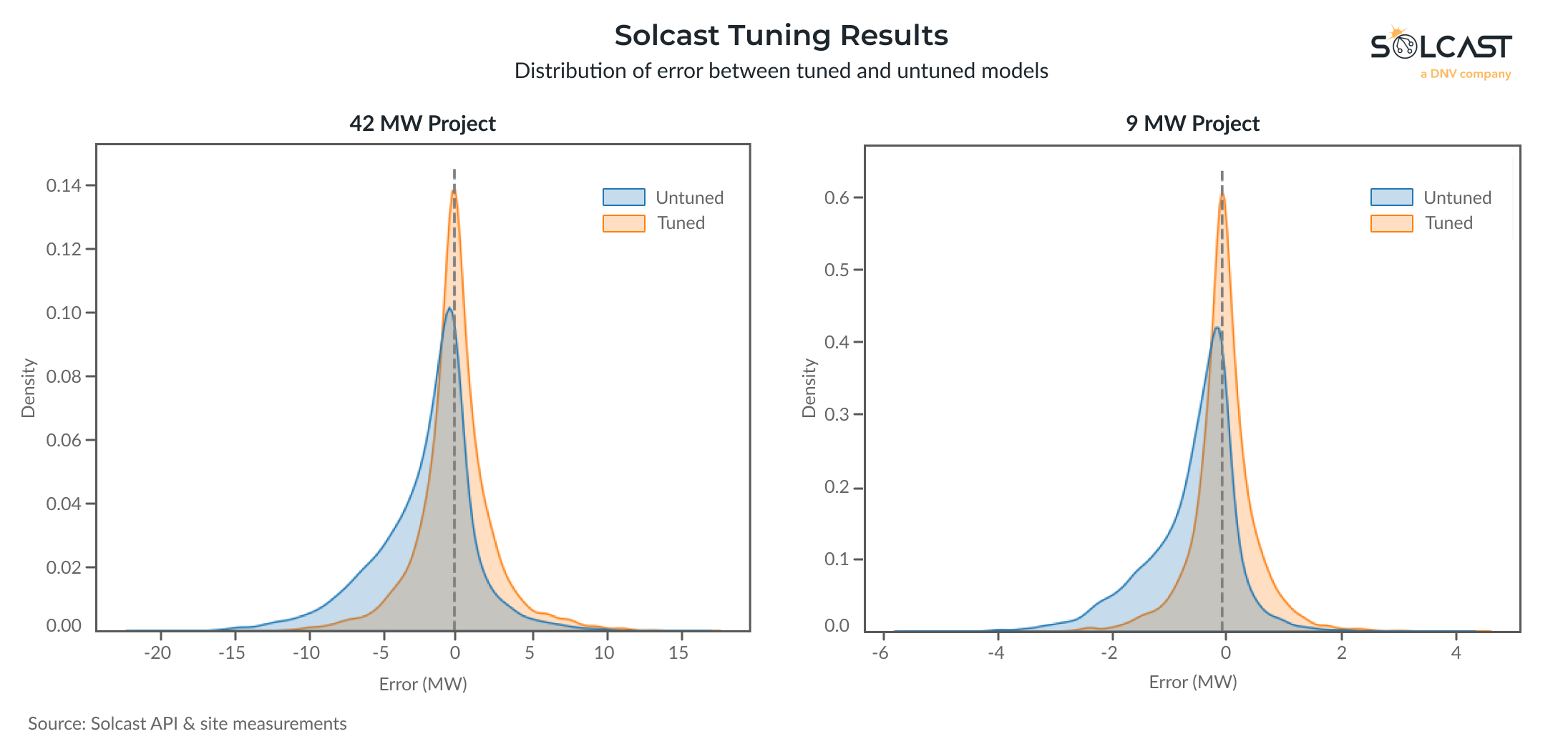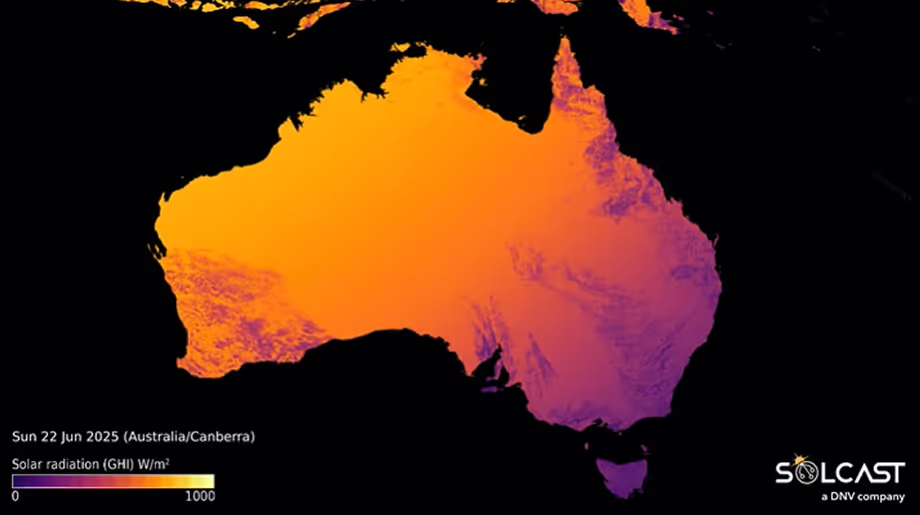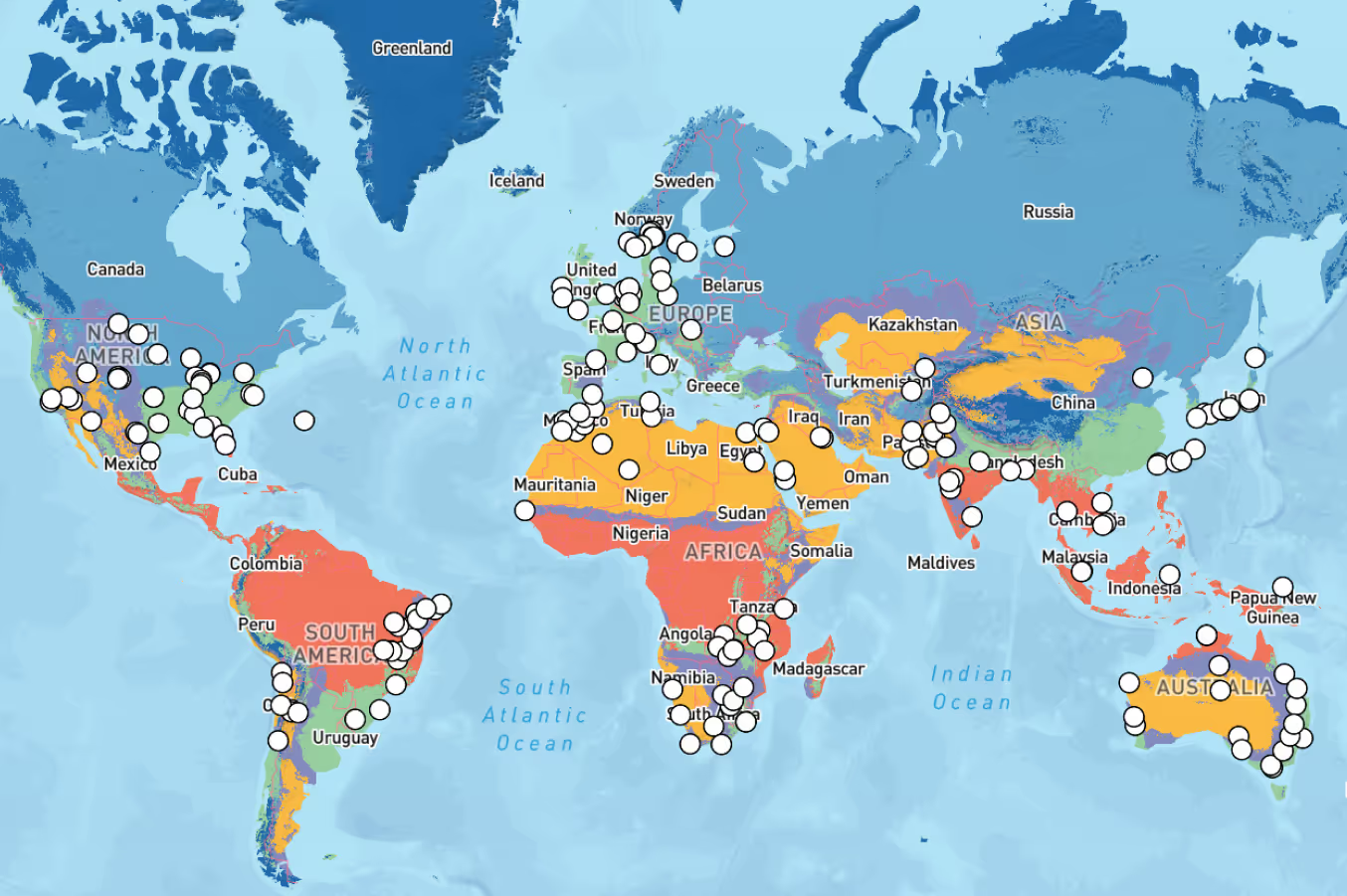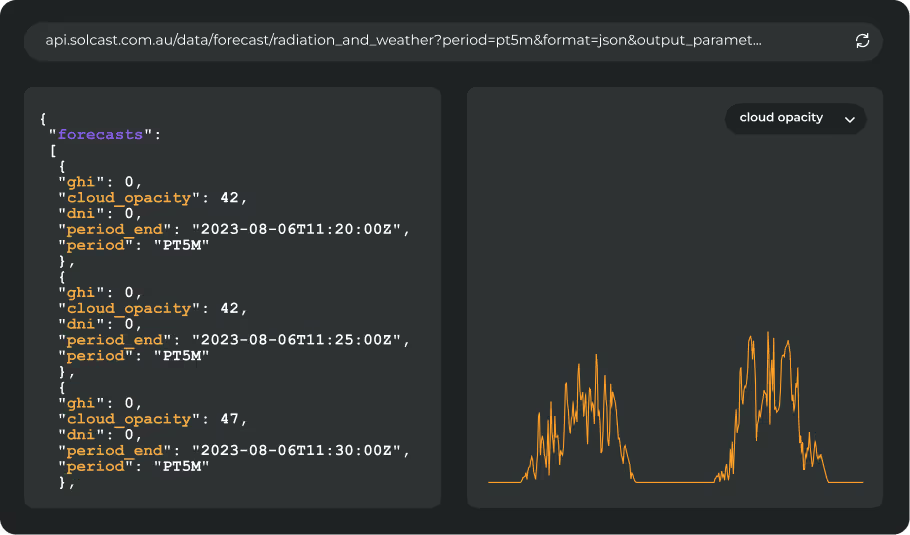Solcast’s Advanced PV Power model is for when forecast accuracy matters. It consumes Solcast’s irradiance, weather, soiling and albedo data, to produce PV power production estimates. The model runs inside the Solcast API, allowing users to retrieve their forecasts directly from the API (or our web toolkit).
This is the power model that was used by Solcast to win a major 8-vendor, 5-site, 3-month forecast accuracy trial in the US in 2023. It’s used by our customers at thousands of Utility and C&I sites on every continent.

Solcast’s Advanced PV Power model is a physical model of intermediate complexity, which can be empirically improved. What does that mean and why is it important?
- Physical means you can specify the actual characteristics of your PV plant and immediately get a sensible forecast. As distinct from empirical models (eg pure ML models) which are over-reliant on a long and clean measurement history and therefore fail in many cases. Physical also means you have control and transparency of your forecast - compared to a fully-ML model which is inherently a "black box".
- Intermediate complexity means it captures the main physical processes, however you don’t need to specify too much - the model has about 25 parameters only, most of which have sensible defaults that are estimated using only 5 key parameters. For a maximum complexity model, including specifying make and specifications of equipment, a bankable power model like DNV’s SolarFarmer can be configured to account for those parameters.
We designed it this way for two reasons:
1. Forecasting customers often don’t have access to very detailed information about their plants
2. Plant operating conditions are often different from the design specifications.
- Empirical improvement is the topic of this article. It means the Advanced PV Power model is amenable to what we call “Tuning”, which can be performed by Solcast or by you. Tuning allows the Advanced PV Power to become more accurate as power production data becomes available.
This article will focus on empirical improvement but you can read more about the methodology behind Advanced PV Power model in detail.
Good use of site measurements: “Tuning” the Advanced PV Power
Setting up your Advanced PV Power model for one or many sites only takes minutes. It can be done via the user interface in our web toolkit, and it can also be done programmatically using our API. Simply create your site, and voila, you can instantly begin getting your solar forecasts from the API or toolkit! Provided you entered the correct site specifications, the accuracy is immediately good.
However, if you want to go from good to great (or even amazing!), or if you don't have much data about your site specifications, or your site is especially complex, then “Tuning” could be worth considering.
“If you don’t have much data about your site specifications, then “tuning” your PV model could be worth considering”
How to tune for your PV power sites?
Tuning is where a history of power production measurements can be used for adjusting the Advanced PV Power to improve its accuracy. Tuning, when performed correctly, ensures the highest possible forecast accuracy.
There are two ways to get tuning for your Advanced PV Power sites, in general we recommend the first way:
- Use the “Accuracy Assist” option when you buy your Advanced PV Power add-on to your Solcast plan.
Our team will assist in the setup of your PV plants in the Advanced PV model, and provide Tuning using your measurement data up to three times per year upon request (when you send us plant specifications and measurement data). You don’t need to do anything else, all you will notice is that your accuracy gets better in the forecasts that you already get from our API. - Stick with the “Unassisted” option, and try your own tuning, using our Python SDK as a guide.
We only recommend this for customers who have a dedicated team that is very familiar with PV modelling and forecasting, and who has the time available to experiment and tune the data on a regular basis.

How does the Tuning itself actually work?
Tuning works in two ways:
- By refining the irradiance to power model itself via optimal estimation of model parameters that may be unspecified or uncertain (think about things like ground cover ratio, tracker behaviour, slope).
- By removing remaining errors empirically once the model is optimised.
We have found that this approach of a physical model with empirical improvement leads to the best accuracy results, and the most robust product that can work on sites with no measurements, bad or insufficient measurements, or good and long measurements.
PV power measurement data quality is key
Solar PV sites are operational plants, connected to real power grids, and controlled by humans. Which means there are outages, there is maintenance, there are periods of curtailment. Therefore the PV power production will reflect not only the irradiance and weather, but also these “non-meteorological” factors.
In practice, it’s rare that we see a plant that doesn’t have these factors, and even rarer to see the details of these factors well captured alongside the PV power measurements. This means that when we perform Tuning for customers who subscribe to Accuracy Assist, our first and most important job is quality control and clean up the measurement data. This is a classic human-machine task, which is currently impossible to fully automate, due to the context and judgement required. Here are some of the instances of bad use of site measurements that could impact the PV power measurement data quality.
Alternative ways to use site measurements
Can’t we simply throw all the data in an ML model?
We notice in the scientific literature, and also in less solar-specialised competitors, a tendency to ignore the physical model process and try to go from the raw input data (e.g. weather models) straight to the target (i.e. power production).
This sounds simple and appealing (why not just let the AI learn the relationships directly from the data?), and in a world where there are no outages, curtailments or maintenance that are unknown, and where there are 5+years of production measurements for every site this approach would tend to work quite well. But in reality we find this is not the case. PV plants with clean and consistent measurements spanning many years are rare. Also, it's difficult or sometimes impossible to control or interpret the data coming out of the "black box" that is a fully-empirical model.
In the case of Solcast, we are already learning the local cloud climate at your site based on years of our own proprietary, world-leading satellite-derived clouds data; we don’t need to try to infer that information from messy PV power measurements. We only need to think about the optimisation of the irradiance and weather to power step of our “model chain”.
Using real-time site data instead of satellite cloud tracking to improve intra-day forecasts
Again common in the scientific literature, and also in less solar-specialised competitors, is the use of real-time measurements (and not satellite cloud tracking) to try to improve the irradiance forecasts for the rest of the current day (intra-day).
These forecasters take this approach because it works, for them, in that it improves their intraday forecast error statistics (e.g. MAE, RMSE), and because they lack the specialisation or resources or knowledge to be using satellite cloud tracking.
When, like Solcast, you have good satellite cloud tracking forecast technology, real-time production measurements aren’t the most effective way to improve intraday forecasts, for some very important reasons.
- You will never forecast an actual ramp in production! Meaning you will never see the clouds coming from the production data feed!
- When there are outages or issues in the production data, your forecast accuracy and credibility is affected. Especially when you want an unconstrained forecast. In cases where you want a forecast reflecting current plant conditions, Solcast offers a set of “apply plant condition” options in the Advanced PV Power model.
- The results are worse than the accuracy already offered by satellite cloud tracking forecasts! This is because we can see the clouds coming, and because the satellite data is so much cleaner and more reliable.
Note: Real-time site measurements can add value to the satellite cloud tracking for a very brief window of 0 to 15 minutes ahead. For customers who have a specific need for highest accuracy in this brief 0-15 minute ahead horizon, Solcast offers a “super-rapid update” service that (carefully) uses site measurements, but uses them in concert with the satellite cloud tracking to better anticipate what’s coming.
Enhance your solar forecast accuracy with improved tuning
With proper tuning and use of site measurement, you can ensure that your PV model reflects irradiance and weather conditions that impact your solar production. This leads to significantly improved solar forecast accuracy and optimised operations. Reach out to our team to learn more, or select the best plan for you and submit a quote request.










.avif)


